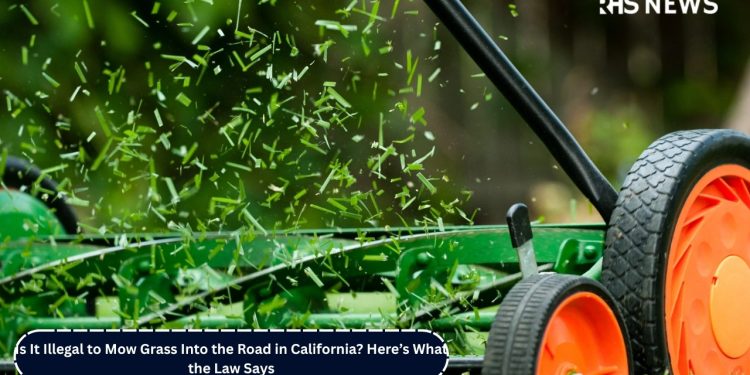California – Lawn care is a common weekend ritual across California, from the green residential neighborhoods of Sacramento to bustling Los Angeles suburbs and serene coastal towns like Ventura. However, as familiar as the hum of mowers and trimmers may be, many are unaware of the legal consequences associated with an overlooked detail: where do those grass clippings go? Specifically, is it legal to leave or blow grass into the street in California? This in-depth article unpacks what California law says, explores why the rule exists, outlines penalties city by city, and shares practical, environmentally friendly alternatives for every homeowner.
Understanding the Dangers of Grass Clippings in the Road
This Article Includes
- 1 Understanding the Dangers of Grass Clippings in the Road
- 2 Statewide California Laws: What the Statutes Say
- 3 Local Codes in Action: City by City
- 4 How Are These Codes Enforced?
- 5 Real-Life Incidents: Safety and Legal Risk
- 6 Littering Fines and Penalties Across California
- 7 Why the Law Matters: Safety, Environment, and Accountability
- 8 Common Questions Homeowners Ask
- 9 Alternatives: Responsible Ways to Dispose of Grass Clippings
- 10 The Broader Picture: Environmental Stewardship and Community Pride
- 11 Final Thoughts
At first glance, stray grass clippings on pavement might seem harmless. Yet, these seemingly innocuous cuttings can cause several issues:
-
Traffic safety hazard: Grass clippings quickly reduce traction on asphalt, especially for bicycles and motorcycles. In cities like San Diego and San Jose, numerous reports highlight the risk of skidding and crashes on roads where clippings accumulate.
-
Stormwater pollution: During rainfall in places like Oakland and Los Angeles, grass and yard debris are swept into storm drains. This leads to nutrient pollution in local waterways, exacerbating algae blooms and harming aquatic life.
-
Clogged drainage: Mulched grass on city streets, as witnessed in Bakersfield and Fresno, can clog drains. Blockages contribute to costly street flooding and property damage, particularly after California’s increasingly frequent heavy rain events.
Given these risks, many municipalities and counties have adopted clear and enforceable laws.
Statewide California Laws: What the Statutes Say
California’s laws regarding grass clippings on public roads are captured by a mix of state and municipal codes. The main statewide law is the California Penal Code, Section 374.4, which prohibits littering or causing any form of litter—including grass clippings—in or upon public or private property not designated for waste disposal. Violators may face fines ranging from $250 to $1,000 for first offenses, with repeat offenders facing even harsher penalties.
Additionally, the California Streets and Highways Code empowers county supervisors to remove debris, rubbish, brush, and grass from public highways, stressing the responsibility of keeping county roads clear for safety and environmental reasons.
Local Codes in Action: City by City
Across California, cities and counties reinforce state law with their own ordinances. Here are examples of how key cities handle this issue:
Los Angeles
The Los Angeles County Code of Ordinances explicitly prohibits dumping or depositing any substance, including grass or yard debris, onto highways or sidewalks if it can pose a danger to road users.
Ventura
In Ventura, the municipal code defines litter broadly, making it illegal to throw, place, deposit, blow, or sweep any waste matter—such as grass clippings—on public property except in designated containers. The city actively enforces this with educational outreach and fines for violators.
Grover Beach
Grover Beach, a coastal city, makes it illegal to blow or leave grass clippings and landscaping debris on city streets. Fines can be as high as $500. This reflects a trend among California municipalities prioritizing road safety and environmental protection.
Other Cities
Cities like Sacramento, Fresno, Santa Clarita, Chula Vista, and Irvine similarly enforce their own anti-littering codes, making it unlawful to place grass clippings or other yard waste on public roadways. Fines and enforcement practices may vary, but the principle is consistent.
How Are These Codes Enforced?
California law allows both code enforcement officers and police to issue citations to homeowners, renters, and commercial lawn care providers who violate these rules. Enforcement typically increases in spring and summer when mowing season is at its peak. In most cases, offenders are given a warning first, followed by escalating fines on subsequent violations.
For instance, in Sacramento, repeated noncompliance can result not only in fines but also stormwater abatement fees if the city has to clear blocked drains. In Los Angeles and Ventura, both home and commercial property owners are liable for any grass that ends up in the public right-of-way, and complaints are taken seriously by city officials.
Real-Life Incidents: Safety and Legal Risk
The issue is not just theoretical. There have been real accidents involving motorcycles and bicycles in cities like San Diego and Long Beach, where riders have lost traction and crashed due to slippery grass on pavement. In some cases, the parties responsible for the clippings have faced lawsuits or legal claims for injuries and property damage.
Littering Fines and Penalties Across California
California’s emphasis on environmental responsibility is reflected in its approach to littering:
-
First offense: Fines can range from $250 to $1,000. The court may also order community service, such as litter removal programs.
-
Second and third offenses: Fines increase significantly, sometimes reaching $3,000, along with mandatory service labor.
-
City-level fines: Cities like Grover Beach and Ventura impose their own fines, up to $500 or more, and can charge for costs associated with cleaning streets or unclogging drains.
Why the Law Matters: Safety, Environment, and Accountability
Leaving grass clippings in the road is more than a minor nuisance. It is a safety hazard for all road users, especially motorcycle riders and bicyclists who frequent city streets throughout California. The environmental consequences—from polluted waterways in urban San Francisco Bay to blocked drainage in the Central Valley—are equally significant.
The law is also a mechanism for fairness. It ensures that property owners and lawn care professionals are responsible for waste generated during their yard work. This accountability keeps communities safer, cleaner, and more pleasant for everyone.
Common Questions Homeowners Ask
Is it illegal to blow grass clippings into the street in every California city?
Yes, in practical terms. Whether through direct anti-littering ordinances or general waste regulations, most municipalities in California prohibit depositing grass clippings on public roads.
I only left a small amount—will I get fined?
Even small amounts are technically a violation, but enforcement usually focuses on visible accumulations posing hazards or environmental risks. A first offense might bring a warning, but repeated or blatant disregard often results in fines.
What about using a leaf blower?
Using a leaf blower is legal, but if you use it to blow yard waste into the street, that’s a violation in many cities. Property owners are responsible for what ends up on the street, regardless of the tool used.
Are grass clippings really that slippery?
Yes, particularly for bicycles and motorcycles. When wet, grass acts like ice on pavement. Numerous reports from biking and motorcycling communities across California, including cities like Berkeley and Santa Barbara, confirm the danger.
Alternatives: Responsible Ways to Dispose of Grass Clippings
-
Mulch-mow: Modern mulching lawn mowers finely chop clippings and return them to the soil, reducing waste and feeding your lawn.
-
Composting: Grass clippings make excellent compost material and are welcomed at local composting facilities or in home garden piles.
-
Curbside green waste bins: Cities across California provide green waste bins for clippings—use them, don’t leave clippings on public property.
-
Sweep or blow back: If any clippings escape onto the street, simply sweep or use a blower to push them back onto your lawn or gather them for disposal.
The Broader Picture: Environmental Stewardship and Community Pride
California leads the nation in green policies and sustainability, from the zero-emission goals in San Francisco to the drought-resistant landscaping movements in Los Angeles and San Diego. Proper lawn care, including the responsible disposal of grass clippings, is a small but meaningful part of this larger ethos.
Final Thoughts
Mowing and maintaining your lawn is a point of pride and routine for homeowners throughout California. Yet letting grass clippings land on the street is more than an eyesore—it’s against the law and endangers both drivers and the environment. Whether you live in bustling urban centers like Sacramento, coastal communities such as Ventura, or suburban neighborhoods in Riverside, remember: keeping California’s streets clear benefits everyone. Always aim your mower discharge away from pavements, collect stray clippings, and dispose of yard waste responsibly. By following both the letter and spirit of the law, you’ll help maintain the safe, clean, and green communities Californians cherish.
Helpful Links
- https://www.reddit.com/r/motorcycles/comments/16f87v7/grass_clippings_in_the_road_how_bad_of_a_hazard/
- https://www.lawnstarter.com/blog/lawn-care-2/california-green-lawn-care-law/
- https://www.cityofbondurant.com/home/news/reminder-blowing-grass-clippings-streets-prohibited
- https://www.avvo.com/legal-answers/is-it-illegal-to-leave-yard-waste-grass-clippings–5809673.html










